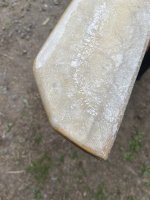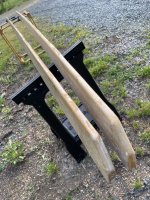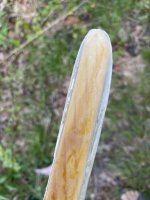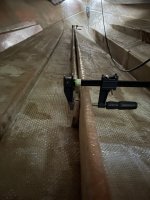This is the set of stringers that I worked on over the winter that you all may remember.
I covered them with several layers of epoxy first of all.
Then I started adding I forgot 6-8 oz cloth.
Then I added csm to really hold a thick layer of epoxy.
I did the tops and sides leaving the bottom untouched as I still had some hull contour to match or get a little closer.
The bottom corners are not squared but slightly sanded round.
Anyway the cloth kept slipping back up creating pockets.
I have fought this 3-4 days.
The cloth 3-1/2” widths.
I’ve tried rolling it. After epoxy is tacky.
I’ve tried working it or milking it back down with rubber gloves.
On the 2nd stringer. I epoxied and rolled the cloth on a table fully saturating and did all the above methods to no avail.
I’m thinking of getting my round router out or sanding these round.
But there’s so many layers of epoxy not sure if it’s worth the trouble.
And I’ve dawn washed these boards and sanded the snags smooth. For a 2nd layer.
The reason for this is to keep water away from the wood and not depend on the tabbing.
To create a really strong barrier. And I mostly have succeeded.
But these pockets are not to my approval.
I have spent 4-6 months on these, not constantly, but 20-30 hours easy.
What would you do.
Let it go or sand it and get it right.
Or just add another layer and call it done.






Thanks in advance
I covered them with several layers of epoxy first of all.
Then I started adding I forgot 6-8 oz cloth.
Then I added csm to really hold a thick layer of epoxy.
I did the tops and sides leaving the bottom untouched as I still had some hull contour to match or get a little closer.
The bottom corners are not squared but slightly sanded round.
Anyway the cloth kept slipping back up creating pockets.
I have fought this 3-4 days.
The cloth 3-1/2” widths.
I’ve tried rolling it. After epoxy is tacky.
I’ve tried working it or milking it back down with rubber gloves.
On the 2nd stringer. I epoxied and rolled the cloth on a table fully saturating and did all the above methods to no avail.
I’m thinking of getting my round router out or sanding these round.
But there’s so many layers of epoxy not sure if it’s worth the trouble.
And I’ve dawn washed these boards and sanded the snags smooth. For a 2nd layer.
The reason for this is to keep water away from the wood and not depend on the tabbing.
To create a really strong barrier. And I mostly have succeeded.
But these pockets are not to my approval.
I have spent 4-6 months on these, not constantly, but 20-30 hours easy.
What would you do.
Let it go or sand it and get it right.
Or just add another layer and call it done.






Thanks in advance
Last edited:



















